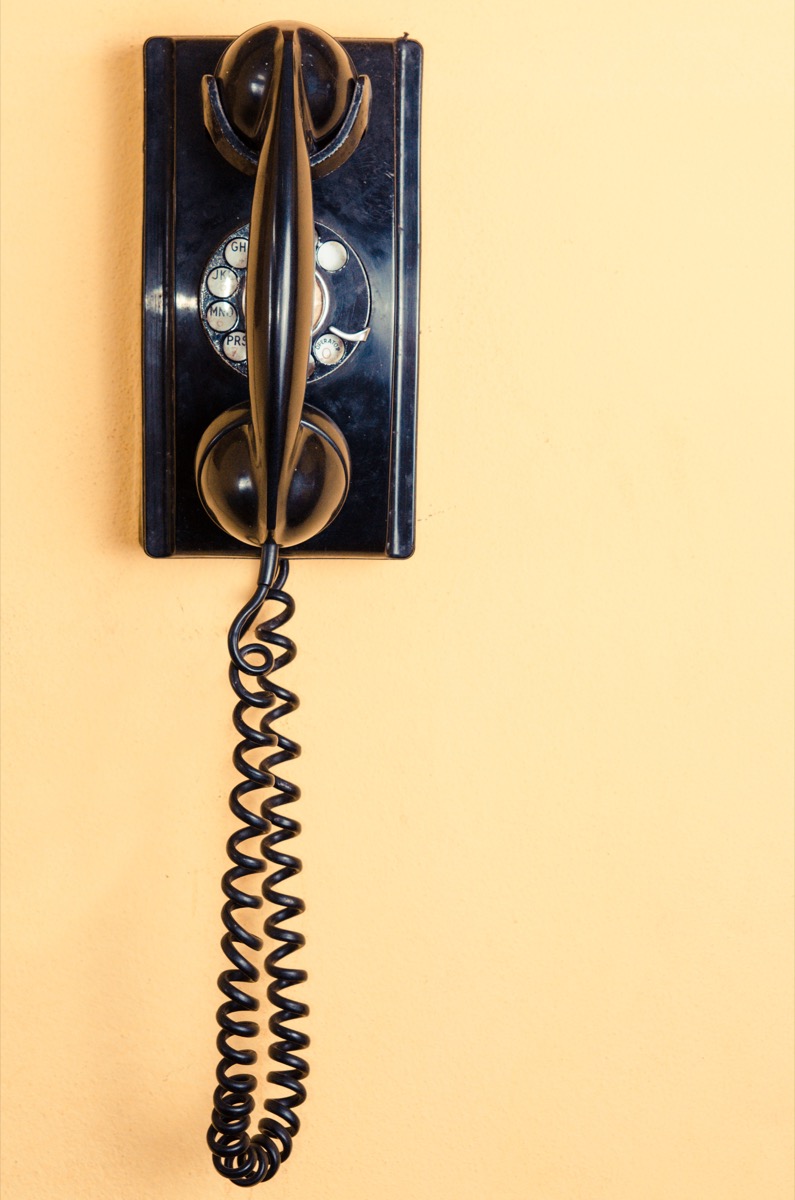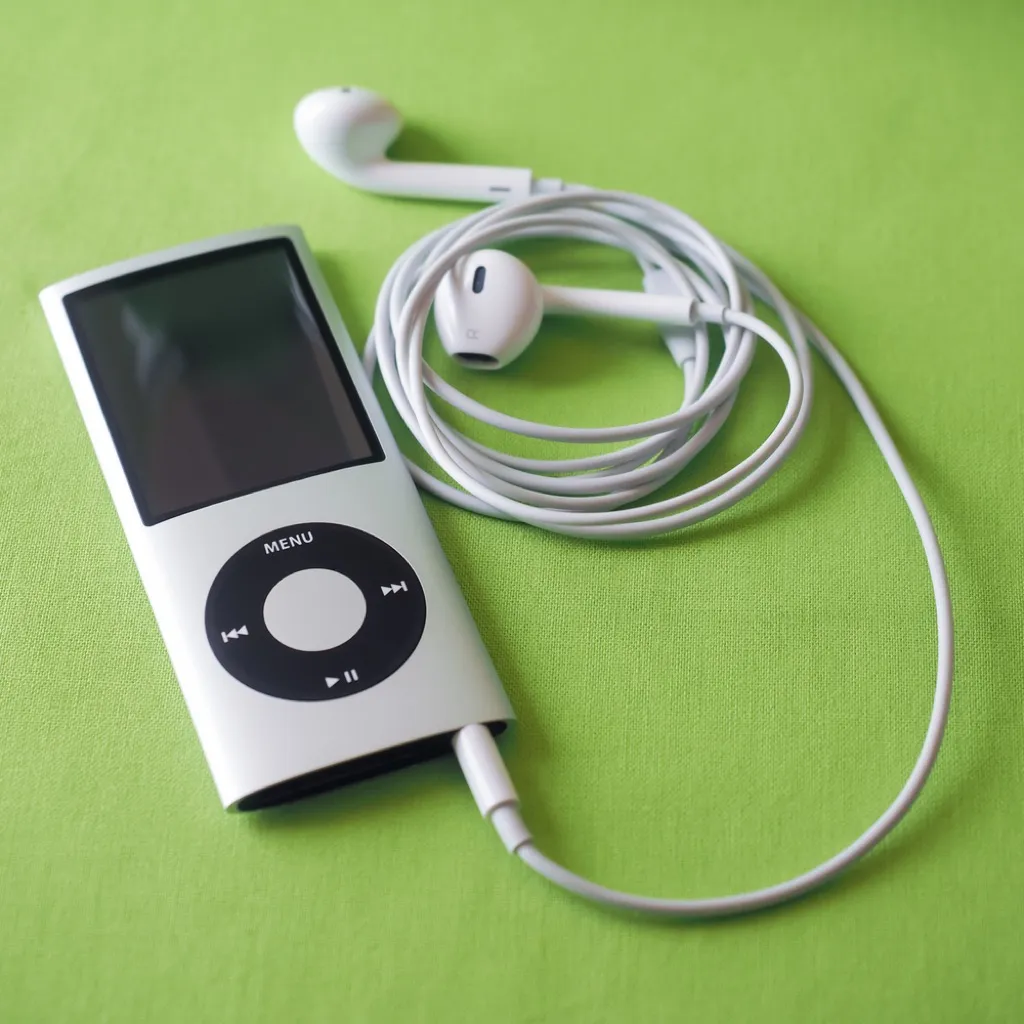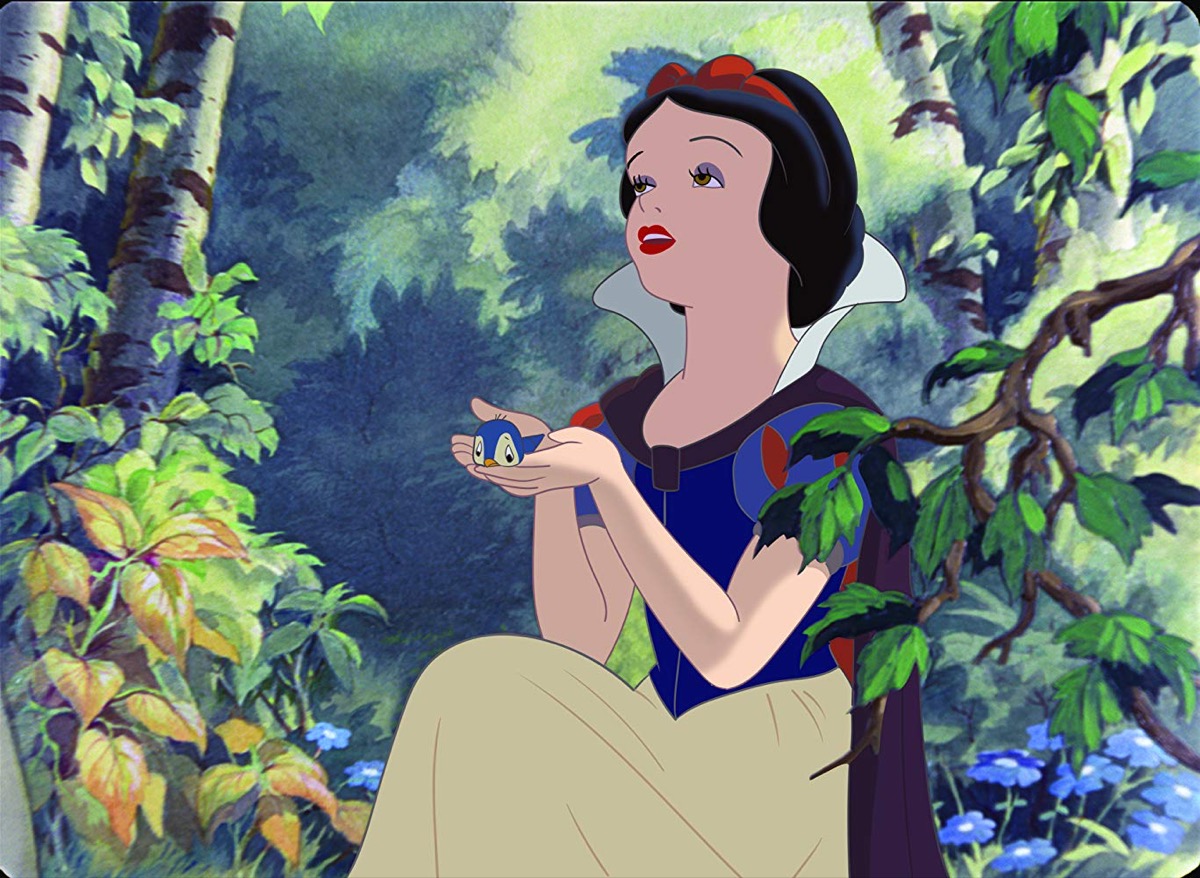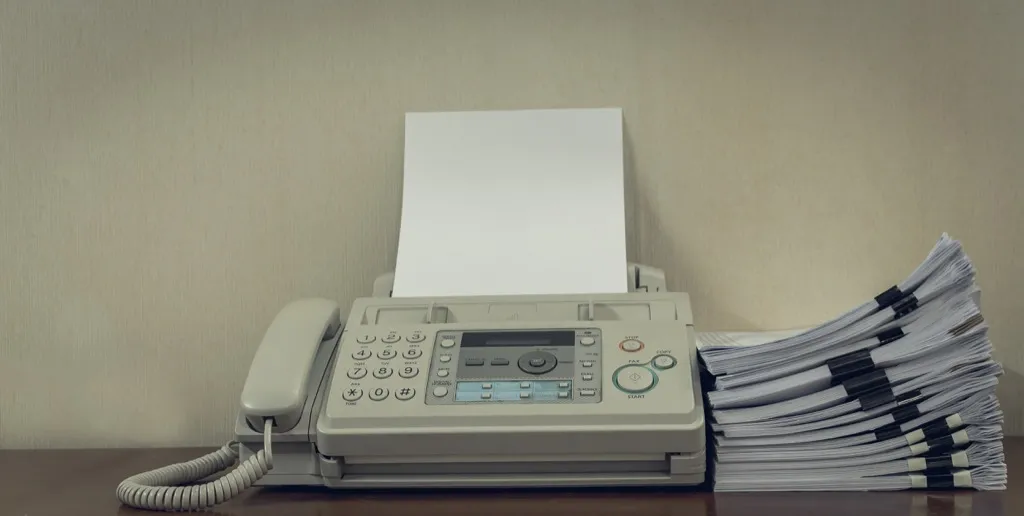29 Inventions That Are Way Older Than You Probably Thought

It can be easy to think that every piece of great technology, every time-saving convenience of the modern world, is a relatively recent invention. Things like social media, brain surgery, and video games are luxuries that have only become widely available over the last hundred years—or less. But in some cases, the things we assume are recent additions to civilization have actually been with us for centuries. Here are 30 inventions with backstories far older than most of us have grown up believing. And for some innovations that might go the way of the dodo, check out the 25 Things That Could Become Obsolete Within the Next 5 Years.
1
The Telephone (Invented around 613 C.E.)

You’ve likely heard that Alexander Graham Bell doesn’t deserve all the credit for inventing the telephone. But if you think Italian-American engineer Antonio Meucci was the true mastermind behind it, you still don’t have the right guy. As it turns out, we have to go back even further in history to find the real origins.
The world’s first telephone, invented by the Chimu civilization, was discovered during excavations in Peru during the 1930s, according to the Smithsonian’s National Museum of the American Indian (NMAI). It’s just two gourds connected by a twine cord, and was used by “elite” members of Chimu society who weren’t allowed to have face-to-face contact with their underlings. As NMAI curator Ramiro Matos explained in an interview with the Smithsonian, “It comes from the consciousness of an indigenous society with no written language.” And for some more modern innovations, check out these 25 Brilliant New Inventions That Will Make Your Life So Much Easier.
2
Video Games (Invented in 1947)

If you thought Pong’s debut in 1972 was the beginning of video game history, you’re off by a few decades. The first video game was actually invented by a physics professor named Thomas Goldsmith, Jr., who patented an electronic game based on old World War II military radar displays. The “Cathode Ray Tube Amusement Device,” as he called it, involved a cathode ray tube connected to an oscilloscope, which used light trajectories to create the effect of missiles being fired at targets. But Goldsmith, Jr. unfortunately never managed to raise enough funds to release his game commercially. And if you were a Pong lover, check out 20 Things All ’70s Kids Remember.
3
Digital Music Players (Invented in 1979)

The conventional story is that the iPod was invented in California in 2001. That may be technically true, but the iPod is far from the first portable music player. That title belongs to the IXI System, created more than 20 years earlier by amateur inventor Kane Kramer and his best pal, James Campbell.
As they pitched it to investors, it was the size of a cigarette pack, and came with a display screen and memory chip that could store three-and-a-half minutes of music. Not a lot, sure—and it didn’t help that nobody had personal computers at the time, so they’d have to visit stores to download new music. According to Wired, their idea “eerily foreshadows the iTunes Store and pretty much any modern online music store.”
4
Animation (Invented around 19000 B.C.E.)

You don’t need celluloid to make animation—and a group of cave paintings discovered in Lascaux, France, created during a time when humans still hunted wooly mammoths, is proof. The moving drawings—of horses that appear to gallop, and birds that seem to flap their wings—could only be viewed with the flickering grease-burning lamps that were placed by the hundreds around the cave.
As Marc Azéma, a Paleolithic researcher and filmmaker, explained in a paper, the cave paintings “invented the principle of sequential animation, based on the properties of retinal persistence.” This was achieved by showing a series of juxtaposed or superimposed images of the same animal. To demonstrate how it worked, Azéma made a video showing how the cave paintings played tricks on the eyes to make it seem like the animals were really in motion. And if you love a good animated movie, here are 16 Classic Family Movies to Stream With Your Kids.
5
Brain Surgery (Invented around 5000 B.C.E.)

In 1997, archaeologists uncovered an ancient grave in the French village of Ensisheim that contained the long-decomposed body of a 50-year-old man with two holes in his skull. After close scrutiny of the skull, it was determined that both holes, located near the frontal lobe, were likely from a surgery rather than blunt force trauma.
Even more remarkably, the surgery, which involved drilling into the man’s skull more than 7,000 years ago, appears to have been successful. Both wounds healed before the patient’s death. No one is entirely sure what the surgery was trying to correct, but, according to one writer for Discover, it likely involved a lot of “cutting and scraping. Stone Age tools were certainly up to the task: Flint knives are actually sharper than modern scalpels.” And for invention trivia, check out these 30 Life-Changing Inventions That Were Totally Accidental.
6
Automatic Doors (Invented around 50 B.C.E.)

The kind of automatic door we’ve grown accustomed to in modern times was invented by two Texans in 1954, but the concept of a door opening of its own volition was first imagined by a Greek mathematician and engineer named Hero (or Heron) of Alexandria.
He came up with the self-opening door as a way to add drama and gravitas to religious ceremonies. The complicated mechanism involved pulleys and buckets, and was intended to make true believers think that a divine entity had opened the doors with invisible hands. Hero even had a system for creating the sound of trumpets when the door swung open, because a Greek god isn’t about to make an entrance without some trumpet fanfare.
7
Vending Machines (Invented circa 50 B.C.E.)

Another contribution to world culture by Hero of Alexandria. The mathematician also came up with a vending machine-type device to make sure people weren’t over indulging in holy water at Egyptian temples.
t worked in much the same way that today’s vending machines do: You put coins in the top and the weight of the coin opened a valve that let the holy water flow out. But eventually the coin slid off the tray and the lever snapped back, and no more water would be released without additional funds. So, those first vending machines weren’t trying to lure you with sodas or salty snacks, just sacramental H2O.
8
Computers (Invented in 1821)

The first person to dream up a computer didn’t have visions of online shopping or word processing; he just wanted a machine to calculate polynomial functions. Charles Babbage, a British mathematician and mechanical engineer, came up with the idea for a computer (or “Difference Engine No. 1,” as he called it) in 1821. It was basically a glorified calculator… that happened to weigh around three tons and was made up of 4,000 different parts.
The British government invested £1,700 in his invention, but apparently that wasn’t enough, as Babbage never completed a working prototype. However, that doesn’t mean it never saw the light of day: In the 1980s, engineers built their own version of Babbage’s computer based on his notes, and it remains on display at the History of Science Museum in Oxford.
9
Social Media (Invented around 1560 C.E.)

There was no Twitter or Facebook during the 16th century, but at least for young people in what is the Netherlands today, there was something close. They called it “alba amicorum,” Latin for “friends books.” It worked pretty similarly to social media today, except everything was contained in physical books that were passed around among friends and social acquaintances. When it was your turn with the book, you could write gossip about friends, tell jokes, share lyrics from your favorite songs, and even argue about politics.
Earle Havens, the curator of rare books and manuscripts at Johns Hopkins University, said in an interview that the similarities aren’t just coincidental: “I think social media is a late form of the book of friendship. Very often when technologies come out, people think of them as this brand new-thing that falls out of the sky, when in reality, Facebook is simply doing something that we’ve needed to do for a long time.” And if you’d like to cut back on social media, here are 20 Genius Ways to Kill Time Without a Smartphone.
10
Reality TV (Invented in 1973)

Decades before housewives had cameras following their every move—and all the way back when Survivor producer Mark Burnett was still a preteen—the very first reality show was introduced to TV audiences, and on PBS, of all places. Titled An American Family, the 1973 series followed Santa Barbara housewife Pat Loud, her husband Bill Loud, and their five kids over the course of a difficult year. The show was a hit, with 10 million viewers tuning in every week to watch Pat and Bill’s marriage fall apart, and to see their son Lance come out of the closet.
An American Family shattered boundaries: On top of being the very first reality series, it was also the first representation of a gay person on a primetime broadcast.
11
Ice Cream (Invented around 70 C.E.)

It’s not exactly ice cream—or at least not the recipe that makes kids chase ice cream trucks during the summer—but Roman emperor Nero Claudius Caesar, who lived from 54 C.E. to 86 C.E., purportedly sent his servants into the mountains to collect fresh snow, which Nero’s chefs would then flavor with honey, nectar, and fruit pulp.
But it took Tang Dynasty innovators to put the “cream” into ice cream. The poor man’s snow cone that passed for dessert wasn’t cutting it for Chinese Emperors. So, around 618 C.E., they tweaked the recipe by adding fermented buffalo and goat milk, which was thickened with flour, flavored with camphor, and served ice cold. And for more ancient trivia, here are 27 Facts About Ancient Rome That Are Eerily Relevant Today.
12
Soft Drink (Invented in 1783)

In 1783, Swiss watchmaker and keen amateur scientist J. J. Schweppe introduced the first carbonated beverage to be sold to the public, peddling his delicious “soda water” to thirsty customers in Geneva. Within just seven years, he was doing such brisk business that he moved his factory to London, and introduced a new flavor (fizzy lemon) to stand apart from competitors.
But the oldest soda in the world is actually Dr. Pepper, not Coca-Cola, as most people believe. The drink was invented at a drug store in Waco, Texas, in 1885, a full year before Coke came on the market. Dr. Pepper was originally called “Waco,” but it was soon renamed after a doctor friend of the drug store owner, Charles Pepper.
13
Flamethrowers (Invented around 678 C.E.)

During the 7th century, the Byzantine Empire had a secret weapon to keep enemies away: Greek fire. Invented by a Syrian refugee and engineer named Callinicus in 678 C.E., it was a highly combustible fluid that could be sprayed from a siphon toward enemy ships and would ignite on contact. It stuck to pretty much anything it was aimed at, and water couldn’t stop it.
The formula is still shrouded in mystery—historians suspect it contained ingredients like petroleum, pitch, sulfur, pine or cedar resin, and maybe some lime—but there were also secret ingredients in there that made it so unstoppable and utterly destructive. Aside from all the burning, Greek fire gave Byzantine armies a psychological advantage as well, as “the bellows used to heat the liquid created a terrifying noise” and the spray was shot out of tubes resembling wild beasts that “appeared to be belching out the fire,” according to one historian.
14
Music Streaming (Invented in 1898)

If you thought the internet was necessary for music streaming, you couldn’t be more wrong. The concept of music streaming first appeared in a New York building basement, with a gigantic device—about 220 feet long—called the Telharmonium, patented in 1898. Invented by a lawyer named Thaddeus Cahill, it essentially transmitted music across midtown Manhattan, to restaurants, hotels, and even homes, by telephone.
The music was performed live on an organ on the first floor, but the magic happened in the basement, with a device that, according a 1906 McClure’s story, gave “the impression of nothing so much as a busy machine-shop, or the center of a considerable manufacturing industry.”
So, how did it work? As the McClure’s reporter explained, the Telharmonium’s “electric waves sent out by the great central machine are transformed, by the familiar device of the telephone, into sound waves, and reach our ears as symphonies, lullabies or other music, at the will of the players.”
15
Nintendo (Invented in 1889)

Almost a century before the Nintendo Entertainment System took the world by storm, becoming one of the most popular consoles of all time, Nintendo was just a humble Japanese company that specialized in playing cards. Fusajiro Yamauchi, a 29-year-old entrepreneur, launched the business in Kyoto, Japan, in 1889, to produce Hanafuda cards (translated as “flower cards”). The cards became a global phenomenon—Nintendo even made a deal with Walt Disney in 1959 to sell playing cards with Disney characters printed on then, which sold 600,000 packs in their first year alone—but were nothing compared to the video game revolution to follow.
It was the grandson of Fusajiro’s son-in-law, Hiroshi Yamauchi, who took a risk with Nintendo, to see if the world would take an interest in a video game about a mustachioed Italian plumber jumping over barrels thrown by an oversized gorilla. And well… you know how this story ends.
16
Fast Food (Invented around 500 B.C.E.)

Not many ancient Romans had luxury home extravagances like kitchens or dining rooms. When they wanted a hot meal, they got it on the street, from a fast food joint that delivered classic fare for the busy Roman on the go. Roman fast food restaurants, or “thermopolia”—which translates as “places where hot drinks are sold”—were like McDonald’s, but with alcohol.
They opened to the streets, and had big counters where most customers sat and gorged on the Roman equivalent of a Big Mac and fries—which apparently involved lots of lentils, meat, cheese, and a warmed spice wine. As historian James Ermatinger explained in his book The World of Ancient Rome, “The food was hot and ready to sell, and was prepared to be eaten on the run rather than sitting down.”
17
Batteries (Invented around 250 B.C.E.)

The so-called “Baghdad Battery,” discovered just outside Baghdad in 1938, was a clay jar with a stopper made of asphalt from 250 B.C.E. An iron rod ran through the asphalt, and was surrounded by a copper cylinder. Tests at the General Electric High Voltage Laboratory in Massachusetts showed that the jar had once been filled with a substance like vinegar, and when researchers made replicas, it was capable of producing up to two volts of electricity!
18
Submarines (Invented in 1578)

If you need proof that sometimes the most spectacular ideas come from the most unlikely places, get this: The original idea for a submarine was first suggested by an innkeeper named William Bourne in 1578. Granted, he was also a genius mathematician. Bourne’s submarine prototype, the plans for which he self-published in his book Inventions or Devises, was made of wood, surrounded by waterproof leather, and was powered entirely by oars. But, because he was more of an idea man than an engineer, he never had an opportunity to test his theories.
However, in the 1620s, Cornelius van Drebbel, the “court inventor” for James I of England, built what’s usually acknowledged as the first working submarine. It was essentially just a well-insulated rowboat with 12 oarsmen that traveled underneath the Thames River at depths of up to 15 feet below the surface.
19
Contact Lenses (Invented in 1508)

When you hear the name Leonardo da Vinci, your first thought is likely not, “Oh, that’s the guy who invented contact lenses.” But that’s the truth! In his 1508 book Codex of the Eye, Manual D, da Vinci explained how a cornea could be strengthened by putting it in direct contact with water, either by submerging one’s face in a bowl of water—or by wearing glass hemispheres filled with water.
But it was an impractical idea that wasn’t tested successfully until 1887, when German physiologist Adolf Eugen Fick created a contact lens out of heavy blown glass that protected the cornea with a dextrose solution.
20
Escalators (Invented in 1859)

The first escalator was invented by Nathan Ames, a Harvard-educated lawyer who also wrote poetry about pirates. His 1859 patent for the escalator, which he called the “Revolving Stairs,” would allow people to, as Ames described it, “ascend and descend from one story of a building to another, without exerting any muscular strength.” In other words, the only people using Revolving Stairs would be “the sick, aged, and infirm.”
Though Ames never got around to building a set of his innovative stairs, a version of it premiered as a novelty ride at Coney Island in 1896. Created by engineer Jesse Reno, who called his invention an “inclined elevator,” it was just a vertical platform with no steps, and included handrails so that passengers wouldn’t end up sliding down like kids on a playground. Reno insisted that his invention was “manifestly superior to vertical elevators… because people are handled by it continuously and without delay and no attendant is required.”
21
3D Films (Invented in 1922)

When you think of 3D movies, you probably think of the 1953 classic House of Wax or 2009’s Avatar, which used RealD 3D technology. But 3D has been around much, much longer than either of those films. The first ever 3D cinematic feature was a 1922 silent film called The Power of Love, a romance about two lovers who have to murder her evil fiancé before they can be together.
The brainchild of producer Harry K. Fairall and cinematographer Robert F. Elder, the three-dimensional effects were created with a “dual strip” red-and-green anaglyph format, which required audience members to wear anaglyph glasses. Whether because of the special effects or the plot, the movie didn’t get a wide following. It screened just twice—once in Los Angeles, and shortly after in New York—before disappearing forever.
22
Toilet Paper (Invented around 589 C.E.)

Before the 6th century, rich people used things like wool and lace, and the poor either rinsed in rivers or used leaves or even seaweed to keep themselves clean. But in China, especially among the more wealthy citizens, paper was the preferred choice for self-cleaning after a bathroom visit. The first record of paper being used in the bathroom came from Chinese scholar-official Yan Zhitui in 589 C.E. Of course, the Chinese were careful about what kind of paper they used. Yan observed that “paper on which there are quotations or commentaries from the Five Classics or the names of sages, I dare not use for toilet purposes.”
23
The Seismoscope (Invented in 132 C.E.)

The world’s first earthquake-detection machine was dreamed up by Chinese inventor Zhang Heng in 132 C.E., and it looked like something out of Game of Thrones. It’s basically a bronze vessel surrounded by eight dragons, each of which has a small bronze ball in its mouth. How it worked, exactly, is something of a mystery. Some historians have theorized that a pendulum in the center of the vessel would be moved by seismic activity, causing one of the dragons to spit out a ball and giving a general geographical direction of the tremors, so officials would know where to send help.
24
Automobiles (Invented in 1769)

Designed by French engineer Nicolas-Joseph Cugnot, this 1769 early prototype, invented even before the American Revolution, was a tricycle powered by a stream engine, and yes, it was exactly as awesome as it sounds. There were a few drawbacks, of course. It only moved about two miles per hour, and it had to stop every 15 minutes to be recharged.
In 1771, it caused the first automobile accident when Cugnot drove his creation into a brick wall. Not surprisingly, his investors soon lost interest, deciding that a weird-looking bicycle that travels as fast as a very sick horse while looking considerably sillier was maybe not the wave of the future.
25
Central Heating (Invented around 350 B.C.E.)

If you lived in Ancient Rome and were wealthy enough to afford it, a system called a “hypocaust” that emerged around 350 B.C.E. could keep your home nice and toasty during the winters. It involved raising the home’s floor at least two feet above ground level with a series of pillars made of brick, mortar, or concrete. In that empty space, there would be furnaces that burned fire constantly, and the hot air would circulate under the floor and into flues built into the walls. An ingenuous bit of engineering, as long as you could be comfortable knowing that your entire house was resting on top of a never-ending fire pit.
26
Text Message Slang (Invented around 1890)

Modern texting isn’t the first time we’ve needed a shorthand when communicating with others. With the arrival of the telegraph in the late 19th century, people were suddenly able to communicate with friends and family who lived far away. But it was also expensive—customers were charged not per word or sentence, but per letter. So they developed what was called “telegram style” to cut costs.
As a New York Times writer explained in 1890, a “salutation may be accompanied by an inquiry by one as to the health of the other, which would be expressed thus: ‘Hw r u ts mng?’ And the answer would be: ‘I’m pty wl; hw r u?’” Just like the kids today, basically!
27
Fax Machine (Invented in 1843)

Fax machines didn’t really become the norm until the 1980s, but their history goes back more than a century before that. The very first fax machine was invented by Scottish mechanic and amateur clockmaker Alexander Bain in 1843, using discarded mechanisms from clocks for his creation.
It worked like this: A stylus, like you might find on a record player, was mounted on a pendulum, where it scanned a flat metal surface and picked up transmitted images. Because it used technology from the telegraph and worked in much the same way as Morse Code, inventor Samuel Morse filed a lawsuit against Bain, which essentially ended Bain’s fax aspirations.
Twenty years later, physicist Giovanni Caselli created a more advanced faxing device called the “pantelegraph,” which he unveiled to Napoleon Bonaparte in 1860. As the French emperor watched in amazement, Caselli delivered the signature of a popular French composer over a 140-kilometer distance between Paris and Amiens.
28
Color Film (Invented in 1899)

Chemist and photographer Edward Raymond Turner used a process he patented in 1899 that involved a rotating disk of color filters to create the very first color film (which features his children playing on a swing, and soldiers marching). Not exactly captivating cinema, but far older than the movies we usually associate with being the first movies filmed in color, like Wizard or Oz and Gone With the Wind. Sadly, Turner died—from a heart attack at just 30 years old—before he had a chance to continue his research and fine-tune the technology.
29
Beer (Invented around 6000 B.C.E.)

Beer is so old, the ancient Sumerians were drinking it (and presumably sometimes too much of it) for 2,000 years before the wheel was invented. As World Guide to Beer author Michael Jackson once claimed, “There is a perfectly respectable academic theory that civilization began with beer.”
But those early lagers of the 6000s B.C.E. tasted nothing like what we consume today. As yeast geneticist Kevin Verstrepen explained in an interview, those Neolithic brews were “likely a bit sour,” because the less-than-sterile brewing methods didn’t keep out the bacteria, and had “some rotten aromas.”